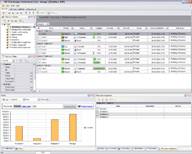 |
|
 |
VIP Task Manager |
 |
|
 |
VIP Task Manager |
|
RUP (Rational Unified Process) splits the project performance into phases each of which consists of one or several iterations. At the iterative approach the volume of tasks on each process varies during the whole lifecycle. Check-points in the end of phases allow to assess how successful the previous phase was and how successful the project was on the whole. RUP defines the following basic processes:
Modeling of business processes is applied to understand structure of an investigated subject domain, to provide unity of understanding of the basic automated processes among all participants of the project and to define high requirements which should be implemented during the project. | ||
Management of requirements allows to come to the agreement with customers and end users, to define what the system should be able to do, to give more accurate instructions to participants of the project about system possibilities, to create base for successful scheduling in the project and estimations of its status at any moment of lifecycle.
Analysis and designing serve for consecutive transformation of the revealed requirements to the system in specification that describes how the finished product should be implemented. It is necessary to understand the difference between analysis and designing. The basic difference is that analysis specifications do not depend on a specific platform and technology. And designing specifications are exact representation of projected system. |
  Play Demo Play Demo
|
|
Implementation is required for the organization of the program code in separate subsystems, transformations of initial code to executable components, testing of the created components and integration of separate components into subsystems and systems.
Testing allows to define and supervise quality of created products, to watch over integration of components and subsystems, whether all requirements to the system were implemented and also whether all revealed errors were eliminated before the system is installed on the equipment of the end-user.
Installation is a process when the developed product is being delivered to the end user. During this process new release and distribution of the software, its installation, training, technical support, beta testing, etc. occur.
Configuration management and management of changes allows to organize effective work with project artifacts, supervise and operate access to them, keep history of changes, provide effective interaction of participants of the project, etc.
Project management includes formation of conditions for effective progress of the project, definition of principles for planning, formations of the team, risk management, budget formation, planning of phases and iterations, trainings. | ||
 |
Environment management allows to carry out support of all participants of the project. This support includes selection and acquisition of toolkit, adjustment and installation, configuration of the process, completion and adaptation of the methodology used for the project maintenance. |
|
|
The project manager requires software to organize and manage the processes in RUP. Using VIP Task Manager he can efficiently plan the project. All mentioned processes by RUP can be represented in Task List View in VIP Task Manager. You need to create nine task groups and name them according to the processes' titles. Each process is a complex of tasks that during the project should be accomplished by the project team. When task is assigned to a participator of the team he gets notification. He can set reminders and so fight procrastinations. The project manager can set due dates, start time and finish time, actual time and calculate time left for the task accomplishment. If the project phase lasts for a week or a month, the project manager can use week view or monthly view in Calendar. For everyday tasks and agendas there is also daily view. |
 Play Demo Play Demo
|
|
 |
|
 |
VIP Task Manager |


